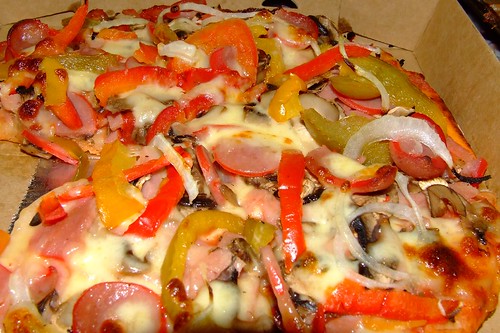A few thoughts about toppings. I’ll start with some observations.
- I just spent some time in Wisconsin, where I saw several menus boasting “gourmet” pizzas, where ‘gourmet’ seems to mean something like ‘has a lot of stuff on it’. There’s often a theme: buffalo chicken pizza, barbecue chicken pizza (seriously, what’s with the chicken pizzas?), taco pizza (a Midwestern delicacy if I ever saw one), cheeseburger pizza, etc.
- Slice joints in NYC have a few standard topping combinations that seem a bit wacky when you take a step back. My local joint Francesco’s sells a pretty good chicken and broccoli slice. Slices with pasta (especially ziti or penne) are common throughout the city. Anna Maria in Williamsburg has a lasagna themed slice that eats like a meal.
- Some pizza places, including a fair number that carry themselves as high-falootin sorts of restaurants, gussy their pizzas up with the fanciest possible toppings. Pizzas boast shavings of 24-month aged Parmagiano Reggiano and slices of prosciutto di Parma. The ever popular Quattro Funghi can read like the mushroom aisle at Whole Foods: cremini, shitake, hen-of-the-woods, oyster, morel, truffle. Lucali charges $8 to add artichokes to a pie, which I assume means that the artichokes grown on the slopes of Mount Vesuvius where they were watered by the tears of a thousand Italian virgins.
So I’m led to ask: What is the role of toppings on a pizza? What should the role be?
In the case of taco pizza and its ilk, I assume that toppings are, as a matter of fact, the raison d’etre of the pizza. When understood correctly (and when executed well) I have no problem whatsoever with this. Look: cheddar cheese, taco meat, lettuce, tomatoes, olives, etc are delicious together, and putting them on top of a pizza, if anything, makes the combination more delightful. I might be a pizza snob of a sort, but I’m not above taco pizza.
The problem with pizzas whose merits begin and end with a set of toppings is that it creates an anti-pizza mindset in regions where such pizzas are popular. If you have enough individual pies whose existence is justified by toppings, you begin to think that pizza in general is so justified. I developed just such a conception in my own Midwestern childhood, and it took a year or two of living in New York City to begin to appreciate the error of my ways.
Fancy-pants pizza restaurants foster a related misconception of the value of toppings. It’s not that I dislike highfalutin toppings. If I could hook myself up to an IV of cured pork and aged cheese, I probably would. But my sense is that the kind of person who gravitates towards this kind of pizza joint is the angsty foodie. The more exotic (or pure, or aged, or authentic, or rare, or humanely produced, or local) the ingredient, the better it is, or so the thinking goes. Ingredient fetishism is just the kind of phenomenon that the Slice Harvester rails against, and while I’m not so quick to put it down as nothing but status-seeking yuppieism, I do think that a focus on fancy ingredients can produce a myopia similar to that of the Midwestern theme pizza lover.
So what is the proper role of toppings on a pizza? To espouse some brand of purism (one topping only! Italian toppings only! traditional Neopolitan toppings only! cheese only!) is to oversimplify. Toppings have an important practical role to play in the pizza economy (remember the lasagna slice that eats like a meal? When’s the last time you said that about a plain slice?). And there’s something transcendent about the perfect topping or two on the right kind of pizza (I don’t know where Totonno’s gets its pepperoni, but I would like to live in a house made of it), such that I would never want to do recommend against toppings altogether.
Maybe I can recommend this: People who generally order the supreme, or the lasagna slice, or the artichoke guacamole tahini pizza on rice dough, might do well to cleanse their palates with a plain pie every now and again. It might turn out that the plain pie at their favorite place is truly terrible, in which case the supreme will have proven its worth. But there’s always the chance that you might discover there’s something underneath all that crap.



So what is the proper role of toppings on a pizza?
I did not realize that we’d be grappling with such serious questions here! But, since you’ve raised the topic, I’ll give it a shot:
Toppings need to be examined within the overall gestalt of the slice upon which they have been baked. Deployed judiciously, they can work in concert with other elements of the pie to produce a satisfying bite. Pepperoni, as you note, can form the perfect addition to a finely charred crust and a bright tomato sauce. The meat, the cheese, the sauce, and the crust, taken together, create a finely balanced taste that comes together in a crunch of absolute deliciousness.
“Supreme” toppings — taco/lasagna pies and the like — risk turning the slice into a soggy, sloppy mess of starch and cheese, while “fancy-pants” toppings encourage discussion of ingredient pedigree and distract attention from the basics of the slice itself. Both types of toppings tend to obscure the basic elements of the pie, to pave over mediocrity with an extra layer of rubbery cheese. Supreme pies have too little nuance for their own good; fancy-pants pies have too much.
And so, I offer this general rule: toppings should always accentuate and punctuate rather than obscure.
And: chicken, pasta, and broccoli belong in microwave dinners, not pizza pies.